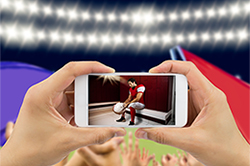Search the latest and greatest job opportunities in sport

GlobalSportsJobs kicks off its seasonal series of trends for 2017 across various sectors and functions in the international sports industry. In this first article we examine five trends in the digital marketing space. From VR and AR to real-time marketing, discover which innovations will impact the sporting landscape in the year ahead.

1. Virtual reality
Virtual reality may currently be the preserve of early-adopting gamers, but 2017 will be the year it goes mainstream. Many industries are experimenting with the nascent technology and, in sport, its potential as a fan-engagement tool is starting to emerge. This new medium offers a more immersive experience than any other and it can fulfil fans’ insatiable desire for a closer and deeper relationship with their favourite sport, team or athlete. VR’s 360-degree experience is perfect for putting fans at the centre of the action, whether it be behind the wheel during a NASCAR race , receiving serve against Maria Sharapova at the US Open, facing world heavyweight champion David Haye in a boxing bout or riding in the Kentucky Derby . Clubs, federations, brands and rights-holders will be following up on these initial forays to deliver more targeted promotional experiences, exploiting this new game-changing genre, which will shortly prove its worth as the ultimate engagement tool.

2. Augmented reality
Image-recognition apps like Blippar allow users to snap something real and tangible, like a ticket or magazine, and turn it into an interactive experience. The most famous example of AR so far is, of course, Pokemon Go, but in sport NFL team Denver Broncos have shown the way with their ‘Come to Life’ campaign on their ‘Orange Herd’ app. A quick picture of a code on a plastic cup takes the fan into an interactive world, where, amongst other things, they can take a picture of themselves alongside their favourite player, tour the players’ dressing room, win prizes and access exclusive content. It gives fans that much-craved feeling of behind-closed-doors access. The marketing potential here is immense; increasing brand loyalty and affinity, measurable monetising through merchandise, ticket sales and exclusive offers, growing its fan base and (not to be underestimated) collecting user data. Similar to VR, this medium is less about presenting the audience with content as websites and social media do, and more about bringing fans into a real environment, enriching their experience and deepening their connection. It’s another obvious growth area as we enter 2017.

3. ‘Real-time’ marketing
Content marketing campaigns tend to be crafted over several months, but that can be incompatible with a fast-moving industry like sport. The marketing value of winners is transitory, as sooner or later, in one way or another, they are bound to lose (as Ryan Lochte and Maria Sharapova will attest). Reacting quickly is therefore vital for brands, clubs, federations and rights-holders to capitalise on what’s ‘trending’. This is why we will probably see lots more activity in 2017, like Sport Chek’s real-time strategy during the Rio Olympics. The Canadian sporting goods retailer posted a five-strong team inside a ‘war room’ at the CBC broadcasting studios in Calgary. During the Games they identified key moments and constructed four ‘real-time’ campaigns around them. The resulting videos were shown immediately on social media and other digital platforms. ‘Real-time’ digital content is expanding generally, including Sky Sports’ deal with Twitter to show instant Premier League football highlights and the Wimbledon Championships’ excellent digital content, which offered match highlights, stats and behind-the-scenes clips within seconds.

4. Broadcasting rights
Millennials are neglecting TV and consuming sport on digital platforms, enabling them to personalise the experience with live in-game chat, stats and user-generated content. The sports broadcasting landscape is clearly changing and this has spawned some innovative new digital marketing strategies. Table Tennis England, the national governing body, recently sold rights to their European qualifying match against Greece to THESPORTbible, an online community for young sports fans. Live coverage was streamed on their Facebook page and was watched by 2.1 million people. The new era was truly heralded by the National Football League (NFL)'s deal with Twitter for digital streaming rights to live Thursday night games. Such a global, game-changing development proved that the traditional, linear broadcasting model is fading and in 2017 audiences must be reached in nuanced and creative ways.

5. Mobile notifications
It's a long time now since we were first dazzled by receiving instant news or goal alerts via text message. Looking back, such services were one of the earliest examples of digital fan engagement. Now these 'push' notification services are getting more sophisticated and in an effort to reach more customers instantly, digital marketers are creating richer, better targeted content to ping directly to our mobiles. Notifications can drive high levels of usage and engagement to your best new content; this could be a live press conference being streamed on Facebook, latest match highlights or a big competition. With most people's phones cluttered with apps, notifications (when used astutely and sparingly) may help your digital content be heard above the digital din in 2017.
This article was written by the GlobalSportsJobs insight team.
Give your career in sport a boost with the latest live vacancies in Sports Marketing , or create an account today and stay up to date with all the latest industry knowledge, events and jobs in sport.
Search the latest and greatest job opportunities in sport